Selecting the Right Outboard Engine
The engine is usually the most important and most costly component on a boat. To a large extent, as goes the engine, so goes the boating experience. Making a mistake when choosing an engine — either leaving the boat underpowered or spending too much for too much power — can be costly.
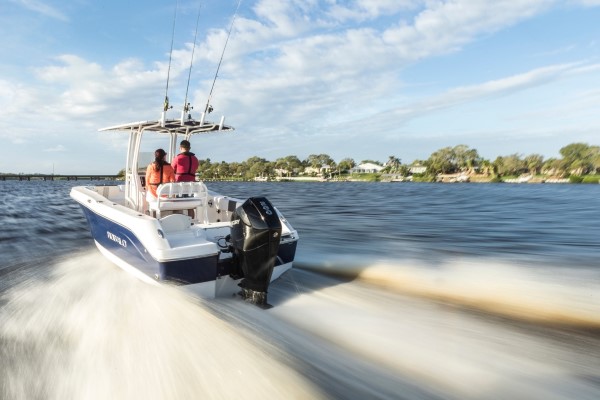
Speed and the Boat’s Hull
The desired cruising speed will be an important factor in engine selection. Those wishing to travel at high speeds will find the purchase price of an engine and boat equally high. The higher the horsepower rating, the stronger the hull must be. Think about it: the faster a boat hits the water, the harder the hit. Think of a car running over a series of speed bumps placed every 30' (9.14 m) across the road. Imagine what would happen to that car if it traveled over a mile or two of those bumps at 70 mph.
The more high-technology materials such as Kevlar and carbon fiber that are used in the hull and the more stringers and bulkheads that need to be put into the boat, to say nothing of a thicker laminate, the more the hull will cost. Those who ever wondered why high-performance boats are so expensive with so little inside them now know one of the answers.
With these things in mind, let’s now look at eight major types of small boats and see what engines might be best for your application.
Consumer Caveat: During our 22 years of testing boats, the most dangerous ones we have tested were all small boats that were overpowered. Never exceed the max horsepower rating on the boat’s metal plate.
Advances in Outboards
- Technological advancements in the design and construction of four-stroke outboards
- Technological advancements in the design and construction of 4-stroke outboards has come a long way since they were first introduced to the American market about 40 years ago. Some of the advancements are as follow--
- Weight. In the beginning they were considerably heavier than the 2-stroke engines they replaced. But over the years, 4-stroke engineers drastically reduced their weight until a number of models were at near parity, before the demise of 2-stroke engines in the U.S.
- EFI. Perhaps the most important advancement has been the introduction of electronically-controlled fuel injection. Today, EFI is standard on all outboard engines except for a few carbureted ones in the low-horsepower range. Cold starting is no longer much of an issue.
- VCT. In the early part of the 21st century 2-stroke engines had a decided edge in low-end torque, and the 4-stroke engine makers introduced “variable camshaft timing.” That allowed to engines to take a deep breath of air sooner to improve low-in torque.
- Intake and Exhaust Manifold Improvements. All outboard engine makers, seeking any advantage possible in fuel efficiency, have refined both intake and exhaust runs to maximize that efficiency.
- Joystick Steering. Introduced first with inboard engines in 2006, it was not long before all outboard makers went digital for both diagnostic read outs and control.
- Auto-Trim. Most engine makers now have auto-trim capabilities.
- All four brands of 4-stroke outboards today are good engines. A buyer will not make a mistake by buying any of the four brands. The mistakes to be made will come in the horsepower selected, the gear ratio, amount of charging power, steering connections, tilt angle, and in some cases, the features chosen.and in some cases, the features chosen.
Check out BoatTEST’s comprehensive buyer’s guide to 209 outboard engines that compares all major published specifications. Click here…

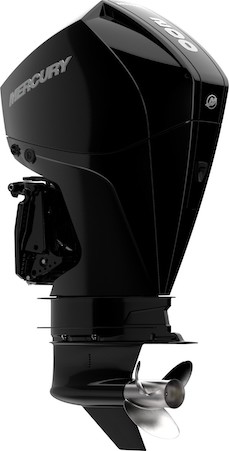
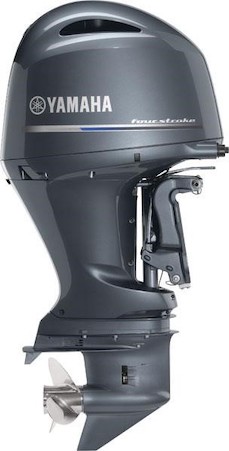
1. RIBs and Inflatables
Inflatables and Rigid Hull Inflatables (RIBs) are not as easy to power as one might think. The days of the little kickers are over except for the compact inflatables that one can roll up and store in a boat’s lazarette or the trunk of a car. Often, the weight of the engine and how much the owner can lug will be the determining factors on max horsepower, usually, 9.9 to 25-hp for small inflatables.
RIBs take more horsepower because they are far heavier than inflatable boats without rigid bottoms. All boats are weight sensitive and RIBs are no exception. For that reason, owners should get as light an engine as possible that has ample low-end torque. That is why 2-stroke outboards were favored for years in many RIB applications.
Low-End Torque is Key. Now, with the demise of Evinrude’s 2-stroke engines, consumers must find the lightest 4-stroke engine with the highest low RPM-range torque available. Torque is measured in Newton meters (Nm) or it foot-pounds, but unfortunately none of the four outboard makers divulges the torque of its engines.
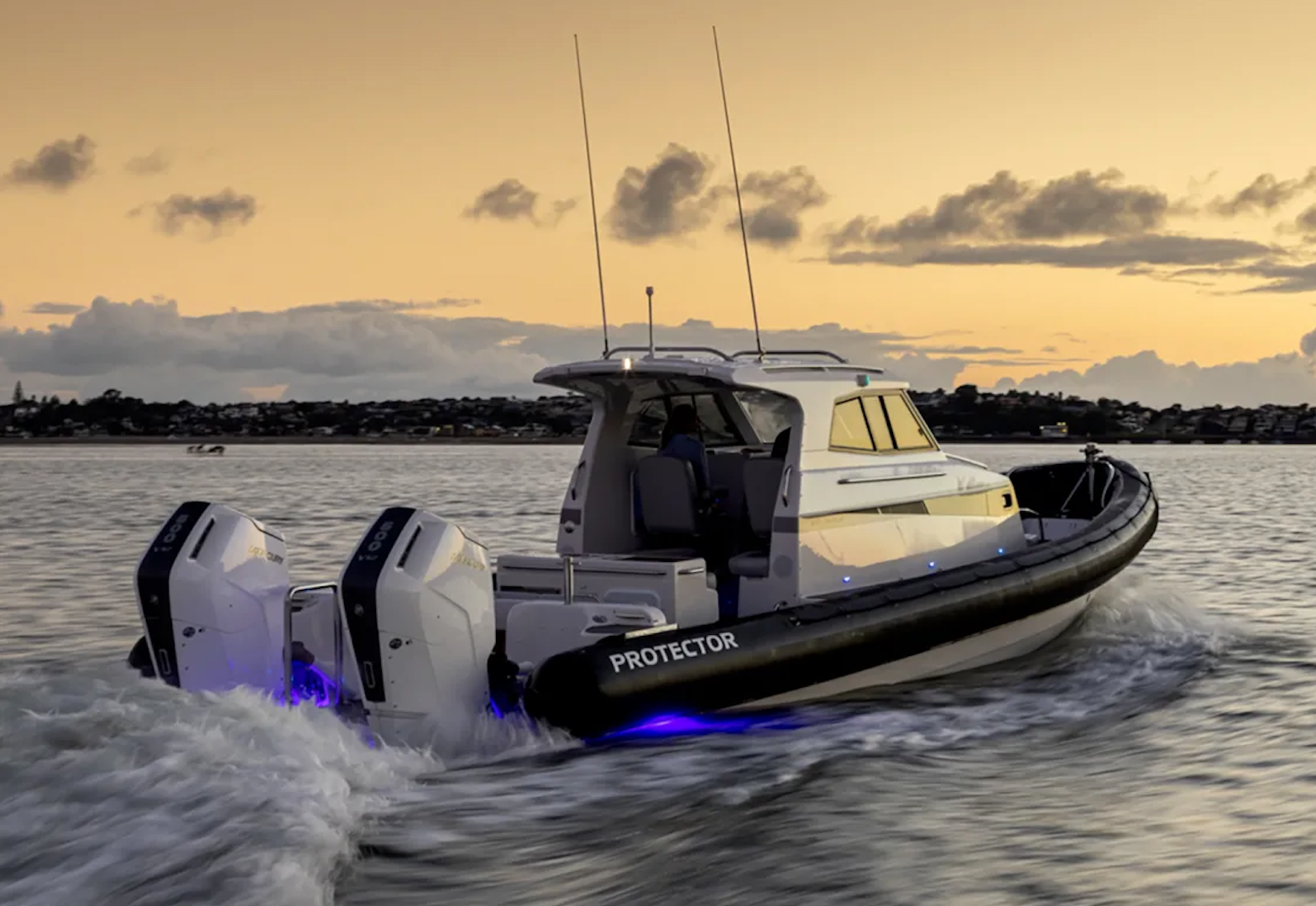
Many RIBs actually draw more water than a similarly sized all-glass or aluminum boat because so much of the beam is the inflatable tube itself, which is not submerged as much as is the fiberglass hull it is attached to. This means more horsepower is needed until the fiberglass or aluminum hull is on plane. Then the vessel flies, due to reduced wetted surface.
The key with RIBs is to get the boat on plane without having to put everyone in the bow to trim the boat while it is building speed. Depending on the size of RIB, we would recommend from 40- to 50-hp as a minimum on the small end, say 12’ (3.66 m) to 14’ (4.27 m). Large RIBs can have two or three big outboards on their transom and they need them to go fast and carry a load.
Small Inflatable Tenders and Dinghies. Honda and Suzuki 50-hp are the lightest on the market, but every horsepower range seems to have its own lightest brand. So buyers should decide on the horsepower needed and then find the lightest model. They are offered with tiller or remote steering.
Check out BoatTEST’s comprehensive buyer’s guide to 209 outboard engines which compares all major published specifications. Click here…
2. Outboard-Powered Aluminum Boats
Aluminum boats can be powered by anything from 25 hp to 300 hp, depending on the size of the boat and the mission. Typically, these boats are used for fishing, so the size of the engine depends on the load to be carried and how fast and how far the owner wants to go.
We recommend that boat buyers calculate the anticipated total weight of the boat with passengers, fuel and gear, then decide what best cruise speed they want to attain if they plan on fairly long runs.
The engine horsepower on any boat should never be more than the maximum rating on the plate affixed to the boat. This is a USCG requirement.
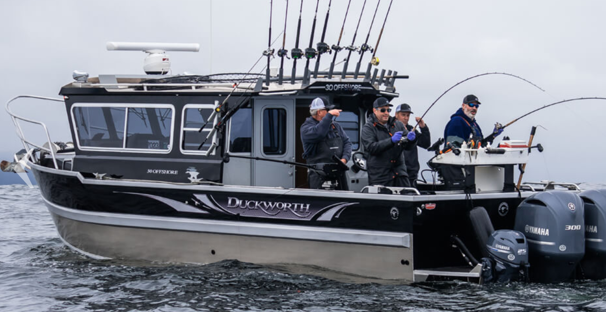
Basically, there are two types of aluminum fishing boats used in North America: 1) The ubiquitous freshwater, low-freeboard, lightweight models for lake and river fishing, and; 2) Large, relatively heavy, high-freeboard vessels that often have a pilothouse or cabin, that are popular in the Pacific Northwest for saltwater and river fishing, and in Canada and points north, primarily in saltwater.
When equipped with 250- or 300-hp outboards, the lightweight types of aluminum fishing boats can typically have a WOT speed of 55 mph to 60 mph, or a bit more, with two people aboard. But engines that large and expensive aren’t required on a 16’ to 24’ (4.88 m to 7.32 m) aluminum fishing boat. Boats in this size range with 115- to 150-hp engines typically have their best planing fuel economy in the 23-mph to 28-mph range with these size engines, and have a WOT speed in the high 30s or mid-40 mph range.
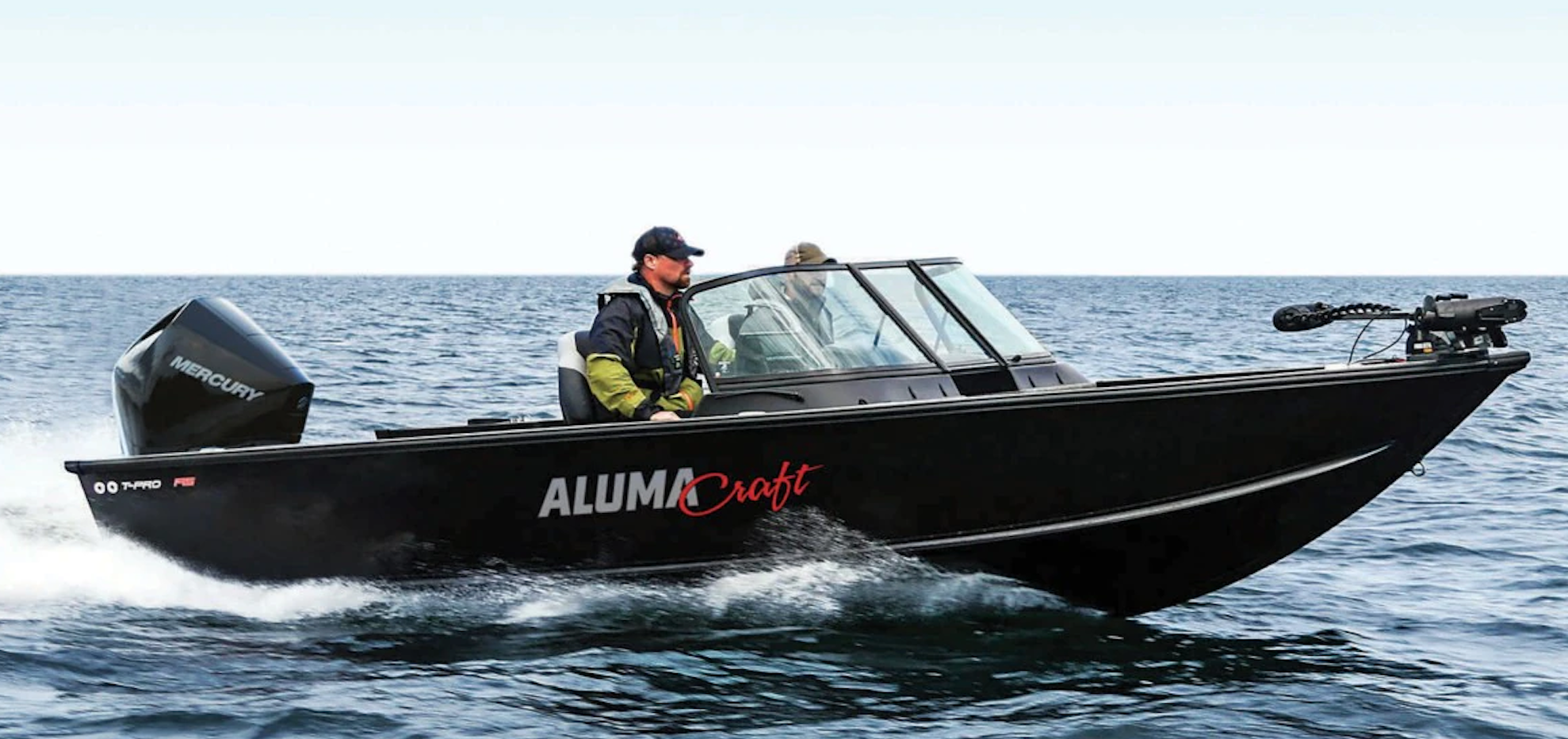
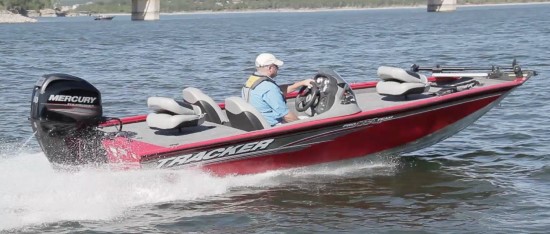
Large, offshore-ready aluminum fishing boats can be powered with outboard engines from 200 hp and higher, depending on size and weight. They typically have WOT speeds in the mid-to-high 30s. However, most owners prefer to operate them offshore in the mid-to-high 20s, where they are much more comfortable. With these vessels, speed is not the name of the game. Owners are more concerned with other issues, such as fuel efficiency, reliability and ease of service.
Before moving up to a large outboard engine, make sure that the boat and the mission require that much horsepower. Some 90-hp engines on 18’ (5.49 m) aluminum boats with two people aboard will perform almost as well at cruise and have a WOT speed in the low 40s.
Typically, a 60-hp engine will propel a 16' (4.88 m) aluminum boat at speeds from 25 mph to 30 mph top speed, depending on load.
Check out BoatTEST’s “Aluminum Fishboat” type to get a good idea of what you might need…
3. Bass Boats
These specialized boats are designed for one purpose — bass fishing. Many bass-boat owners treat their boats similarly to the way collectors of antique cars pamper their classic (and expensive) automobiles. While virtually all builders of bass boats design them for tournament fishing, most people who buy them actually do not enter tournaments and instead use them for low-key recreational fishing.
Having identified at least three categories of the bass-boat owner (tournament anglers, casual fishermen and bass-boat aficionados), it is not surprising that the power needed for all three purposes would be quite different. Boat builders and engine makers spend millions of dollars each year promoting bass boats powered by large outboard engines, but clearly, casual bass anglers can have a satisfying experience with far less horsepower.
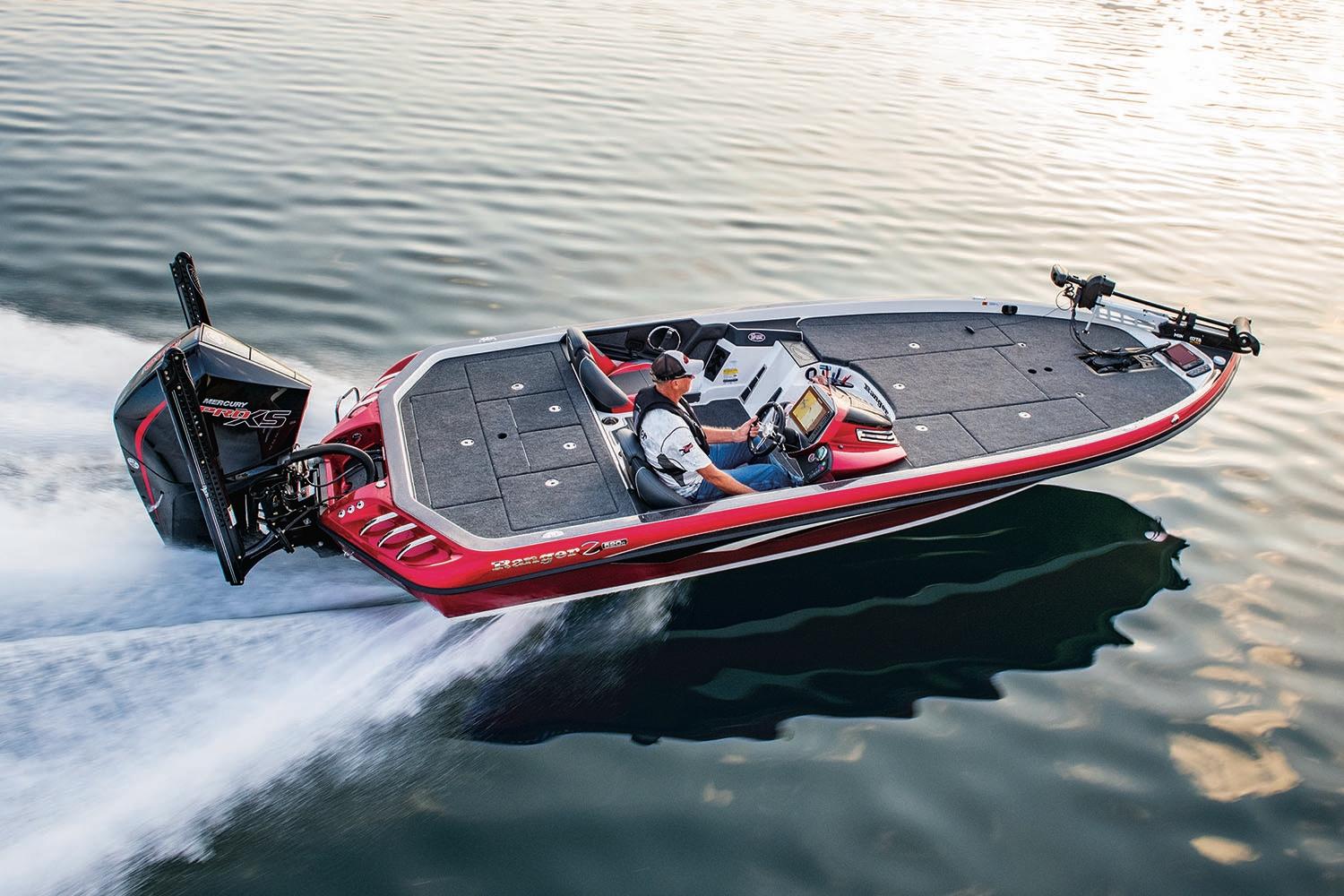
Anglers engaged in tournament fishing are going to want the biggest engine that the boat is rated for, in most cases, and that means from 225 to 300 horsepower. (Be sure to double-check tournament rules because some circuits limit the size of the outboards.) But more casual anglers, particularly those fishing on smallish lakes, have no need for such prodigious amounts of horsepower.
For example, a 2,800-pound (1,270.06 kg) fiberglass bass boat powered by a 150-hp outboard will have a WOT speed in the 50-mph range and will have its most economical cruise in the mid-30s with two people aboard. If your lake is small, perhaps an even lower horsepower engine would serve the purpose. In that case, your major consideration would be finding a like-minded angler come re-sale time.
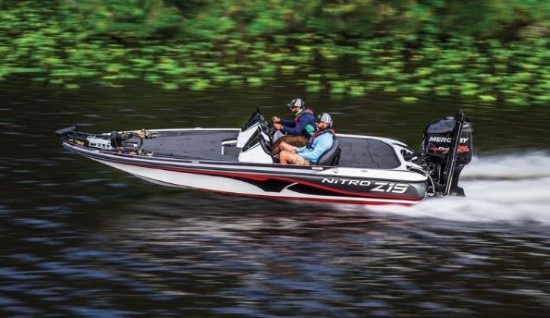
Traditionally, bass boats have been the domain of 2-stroke outboard engines that have lots of low-end torque, which makes for fast hole shots.
Check out BoatTEST’s performance tests of bass boats to get a better picture of what you need…
4. Flats Boats and Skiffs
Flats boats are designed for a specific application — saltwater fishing in shallow coastal waters. Flats boats go where the water is typically calm, so like the bass boat, they don’t need much freeboard. And, like the bass boat, their bottoms are relatively flat, like that of a skiff. When powered by large outboards they can go lickety-split.
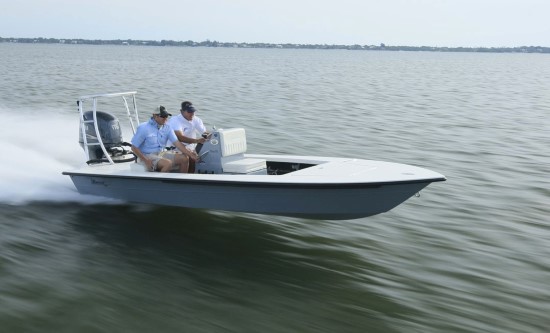
Builders and engine makers often display these boats, which are typically 16’ to 20’ long (4.88 m to 6.1 m), with 60- to 115-hp engines. A potential owner needs to ask how fast and how far he needs to go on an average fishing trip. The answer may be 50 miles or more, in which case he may well want the extra juice so that he doesn’t spend all of his time traveling to and from the fishing spot.
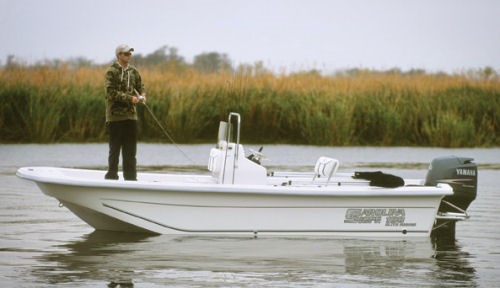
On the other hand, if an angler will be fishing just a few miles from home or the launch ramp, max power may not be needed. Remember, the heavier the outboard the more water the hull will draw. Again, the best cruise and WOT speeds of the boat should guide the buying decision, given the body of water where an angler will be spending most of his time. Like bass boat owners, flats boat owners want a quick hole shot to get up on plane fast in shallow water.
Consumer Caveat: Once again, skiffs and small bay boats can be some of the most dangerous boats on the water if they are overpowered — and this often occurs. Just in the time span of creating this report (3 months), BoatTEST.com had to cancel two tests of flats/bay boats because they were deemed by our test captains to be overpowered and unsafe. We do not publish tests of boats we think are hazardous to use in normal boating situations.
5. Bay Boats
A bay boat is similar in function to a flats boat when it comes to fishing in shallow back waters and bays but by comparison, bay boats tend to be larger, and have more deadrise to their bottoms. With this larger hull displacement and more V in the bottom, you do give up a few inches in draft and the poling platform, which on bay boats is replaced by a bow-mounted trolling motor.
The advantages gained in a bay boat over a flats model may be more square footage of cockpit, larger livewells, additional stowage under the expanded casting decks and typically a better ride in chop. On calm days, many bay boats can even be used in coastal locations, something we don’t recommend for a skiff.
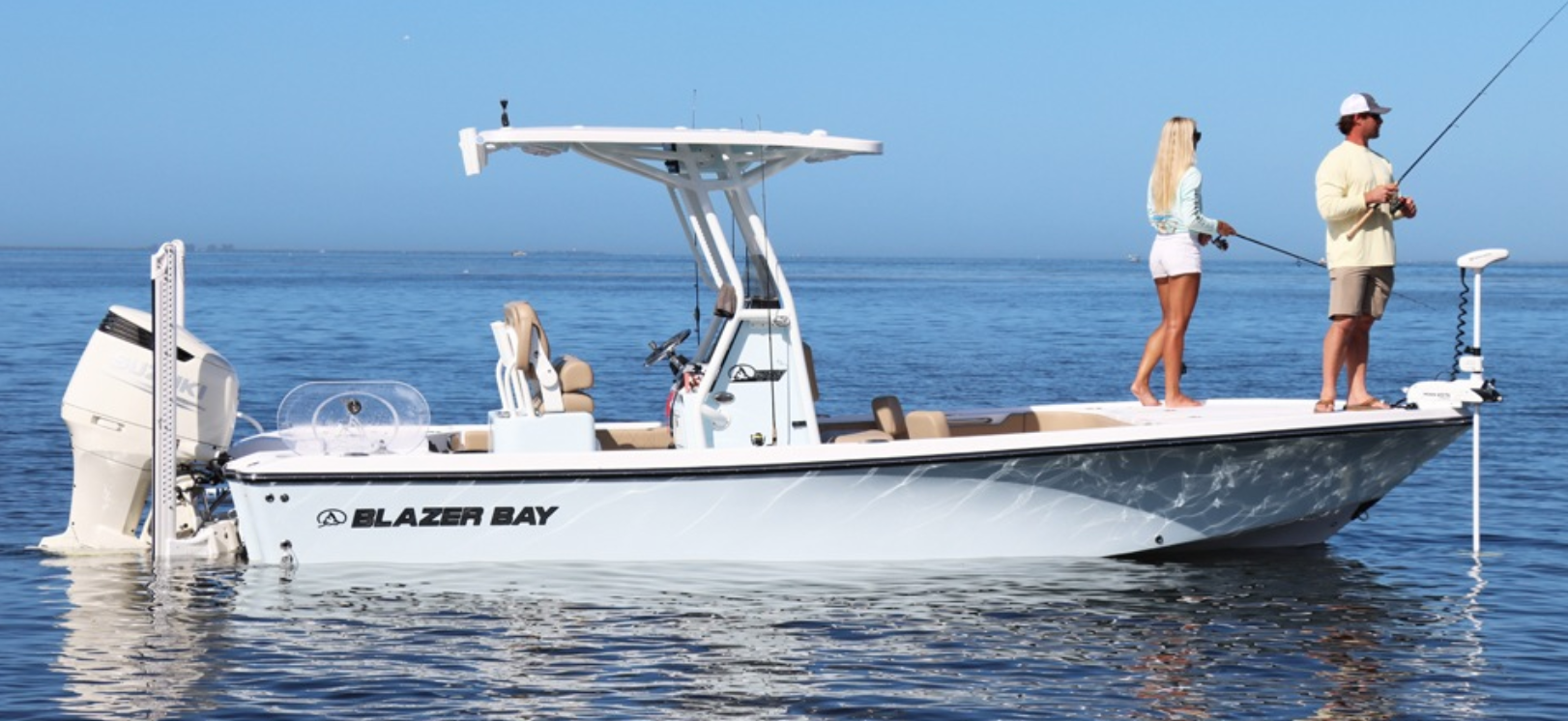
If top-end speed is of value, the larger bay boat can handle more horsepower, plus it is capable of some light offshore duty on a good day. When bay boats first appeared on the scene, it was hard to distinguish whether you were looking at a large flats boat or a small bay boat.
Now the popularity of bay boats has more boat manufacturers adding a bay boat to their lines. The result is that that there are now a lot of choices for the consumer who must match the boat to the body of water where it is intended to be used.
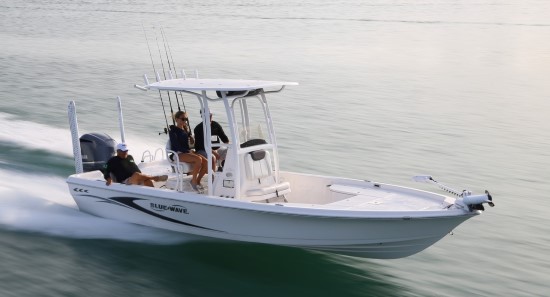
In the bay boat industry, bigger seems to be better, both in the length of the hulls and the outboard motors that power them. Common now are bay boats 20’ (6.1 m) in length with some of the larger craft as long as 26’ (7.92 m). Top-end speeds in the 60-mph range are made possible by outboards producing up to 300 horsepower.
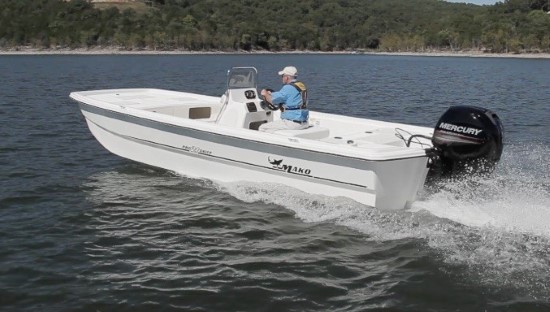
6. Sportboats, Runabouts, & Deckboats
Bigger is Better. The development of bigger and more fuel-efficient outboards has brought about a resurgence of interest in outboard power for sportboats as more and more builders have made these models available. This development is giving consumers a good option that they largely did not have as recently as five years ago.
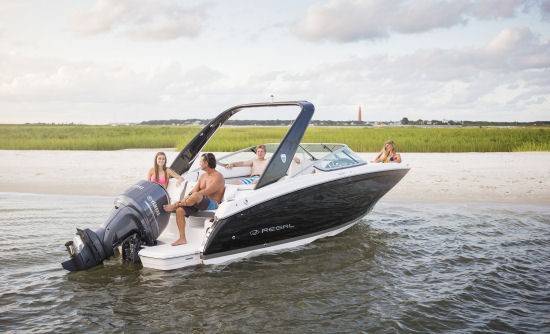
When selecting power for a sportboat, perhaps the most important thing to avoid is underpowering the boat. Some boatbuilders and dealers typically will install minimal horsepower engines in the smallest sportboats to keep the total price of the boat as low as possible. They call them “entry-level” boats.
This package might be sufficient for a youngster just starting, for a newbie couple, or even for grandpa, but for slalom skiing or hauling a boat full of guests, it is simply not enough.
A single 115- to 150-hp outboard motor can produce reasonable performance for an entry-level fiberglass sportboat from 17' to 19' (5.18 m to 5.8 m), depending on the load. With it, a power boat in this range can have a top speed from 35 to 45 mph, with cruising speeds in the mid-20s.
Larger fiberglass boats will need larger engines and today we are seeing 22' (6.71 m) to 25' (7.62 m) sportboats powered by 250-hp to 300-hp engines.
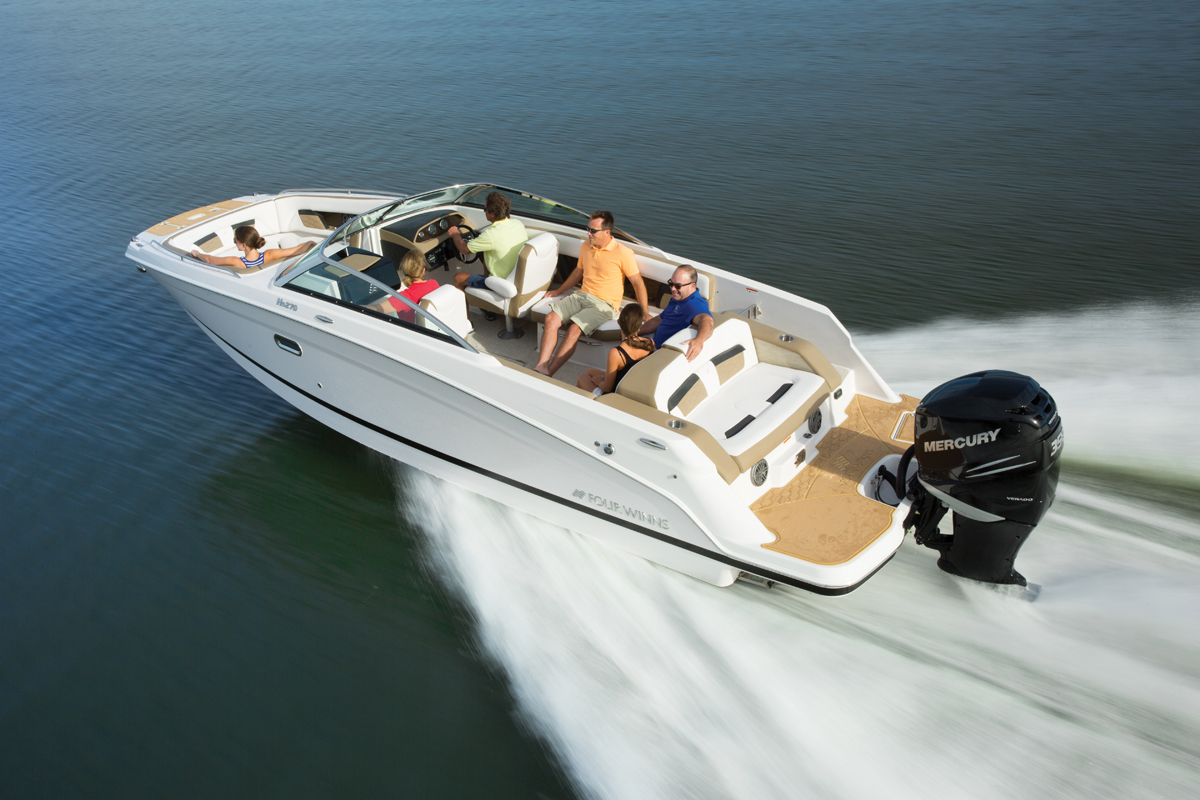
For Towing Sports: Boat owners wanting to tow water skiers and wake boarders should consider engines with strong torque in the lower rpm ranges, because it takes lots of power to get participants up on their boards. And even more power is required when there is a boat load of guests.
But, since outboard manufacturers don’t reveal their torque curves, what is a consumer to do? All that we can recommend is that consumers look at the engine displacement and gear ratio. The taller the gear ratio, generally the greater will be the engine’s torque, particularly at the low-end where it is needed.
A good example of this, is among 200-hp engines. For example, the Suzuki 200HP AP has a gear ratio of 2.50:1. That means that for every 2.5 revolutions of the crankshaft, the prop shaft will turn once. That puts a tremendous amount of power (Nm of torque) into the prop.
Conversely, the outboard engines with the shortest gear ratios (lower numbers), will likely be the fastest at WOT — something that some brands care much about.
Again, check out our Outboard Engine Buyer’s Guide — you might be surprised by what you discover.
Cruising: Sportboats that are going to be used mostly for cruising should be powered by fuel-efficient engines with the horsepower capable of satisfactory performance for the loads carried.
Check out BoatTEST.com’s tests of nearly 200 sportboats and deckboats …
7. Center Console, Walkaround, and OB Small Express
Anglers going long distances want to balance fuel consumption, best cruise speed, and range carefully. It is always wise in a small boat to get back before sundown, and that means knowing how fast and how far a boat can go with the fuel left onboard.
Center console boats from 20' to 25' (6.1 m to 7.62 m) can usually perform well with a single outboard from 200 to 300 horsepower, depending on load and top speed expectations. Over 25' to 26' (7.62 m to (7.93 m), twin engines are typically recommended.
Big Single or Smaller Twins? All outboard engines are much more reliable than they were 15 years ago. As a result, many offshore anglers are opting for the advantages of a larger single rather than smaller twins, equaling the same horsepower. Twins will weigh more and generally burn more fuel at a given RPM and speed than will a single engine of the same horsepower, thus reducing range. On the other hand, some anglers feel more comfortable offshore with redundant power. There’s no right answer.
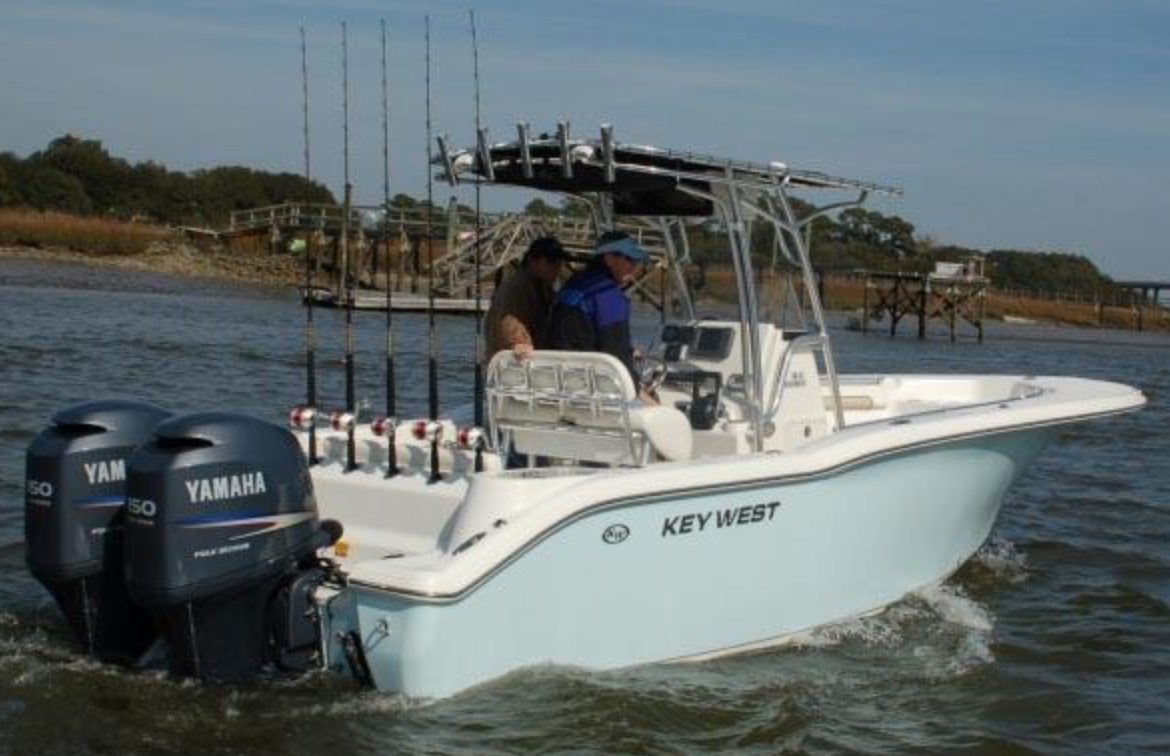
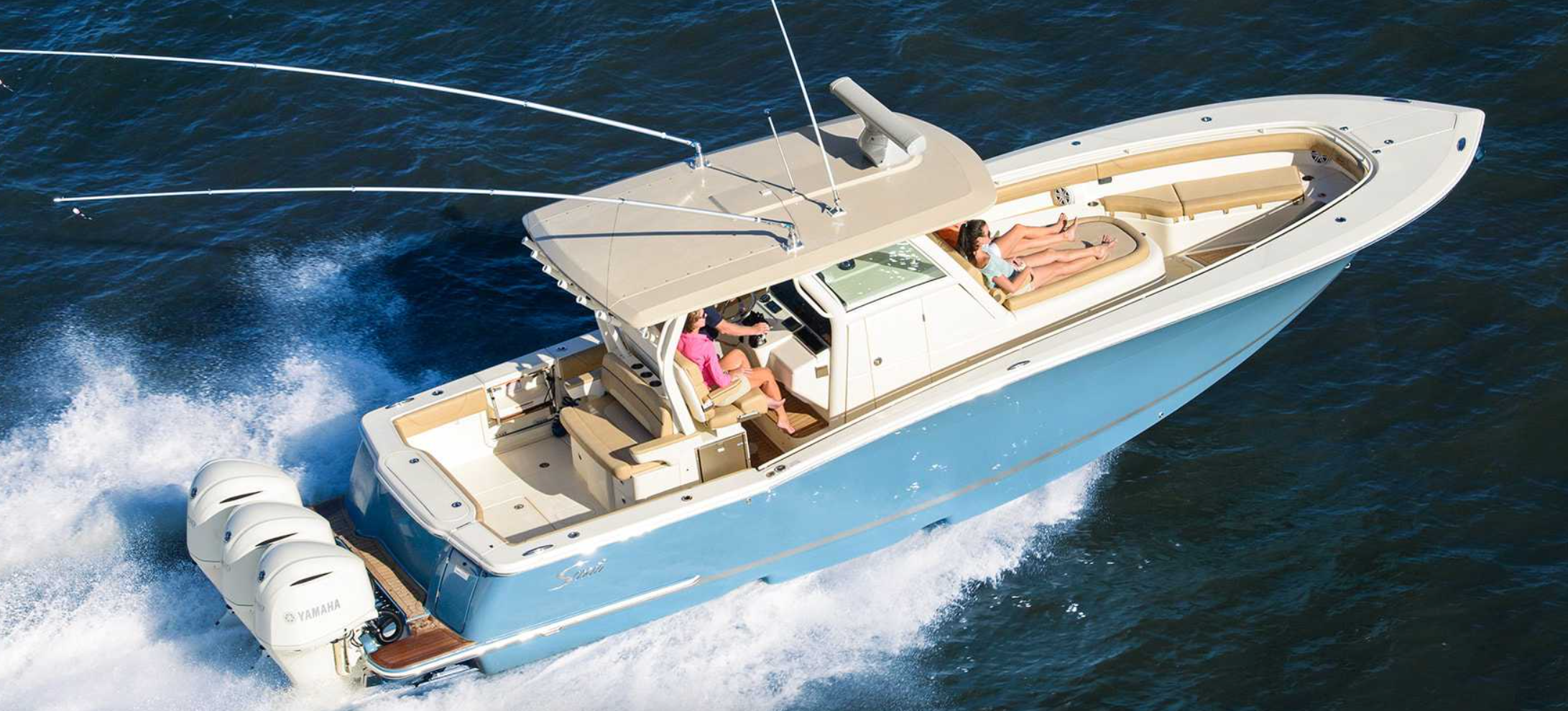
Somewhere around 24’ to 26' (7.32 m to 7.92 m) most boats going offshore will be powered by twin outboards, typically from 200-hp to 250-hp. Around 33' to 39’ (10.06 m to 11.89 m) offshore center consoles will hang three engines on the transom with anything from 225-hp to 350-hp each.
At about 40’ (12.19 m), some center consoles and express fish boats start hanging four engines. Whether or not all of this expensive iron on the transom is necessary is a matter for individual buyers to decide and depending on their respective mission.
Make sure you know what octane fuel your large outboard is recommended to run on. Some require 92-octane fuel.
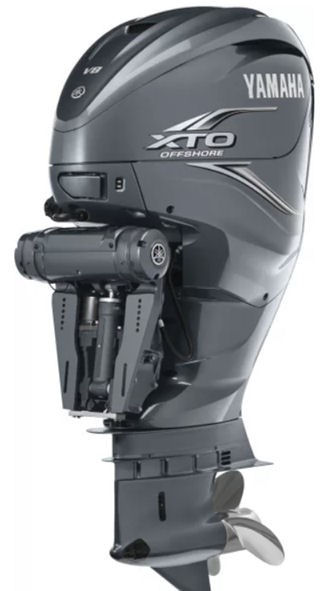
Extra Big Power. Currently, Yamaha’s highest horsepower engine is 425, and Mercury’s is 600. Mercury and Mercury Racing also have engines in the 360 to 500-hp ranges. These engines have special applications, and the boat builders — who have tested most or all of the engines for a particular application, will give the best advice.
8. Pontoon Boats
Growth Spurt. For the last decade pontoon boats have been the most popular type of boat on the market. The invention of the tri-toon has made pontoon boats faster so that they can now be used for skiing and towing, in addition to cruising, swimming and entertaining.
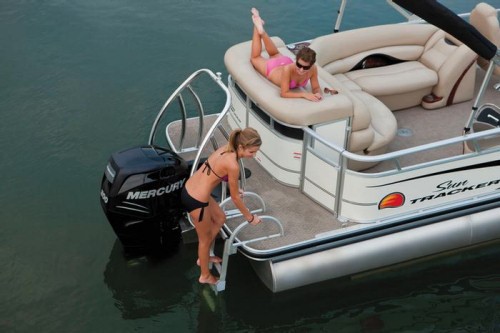
Most pontoon boats have twin pontoons and these are displacement boats; they can only be pushed so fast and adding big engines will not make them go much faster. Depending on how large and heavy the twin toon is, most can be pushed close to their maximum speed with a single 90-hp engine, and many people are quite content with a 50-hp engine driving their twin-pontoon models.
Tri-Toons Are Another Story. Because of their added buoyancy, these boats can get up on "plane" and typically have WOT speeds in the 40-mph range. Some new tri-toons can go 55 mph to 60 mph when powered with twin 300-hp engines. They can be powered with single engines ranging from 150 to 300 horsepower.
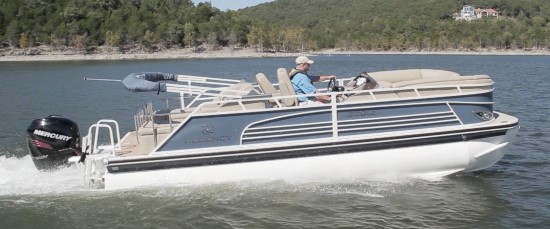
Look at BoatTEST’s tests of pontoon boats to get an idea of how much horsepower you will need…
How Much Speed Does Increased Horsepower Give?
Most buyers are faced with the question of if they buy an extra 50 horsepower, how much faster will the boat go. There is no strict answer because there are so many variables boat to boat.
However, in the outboard engine industry, engineers use the rule of thumb of 1 mph of speed increase for every 7 horsepower added. Our observations are that a 50-hp increase might yield 4.5 mph more.
How much is too much?
Anyone looking to purchase a new outboard, either on the transom of a new boat or to re-power his old reliable craft, should not rely solely on the Coast Guard capacity plate. Just because a boat has a maximum horsepower rating doesn’t mean that you should simply buy a new motor that maxes out the rating.
The old adage of buy more motor and use less of it may apply to some boats while other boats actually run better with less than the maximum rated horsepower. Just as you should pick a category and style of boat that best fits your needs, you should also pick an outboard motor that is the best match for your boat and application.
Finally, remember, outboard companies make their money selling speed and high horsepower — and, while many boat buyers care about top speed for bragging rights, most boat buyers are more interested in fuel efficiency and other characteristics that don’t require so much horsepower.
To compare the specs of 209 outboard engines, visit BoatTEST’s “Outboard Engine Buyer’s Guide”…click here…
